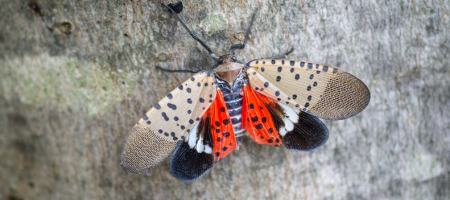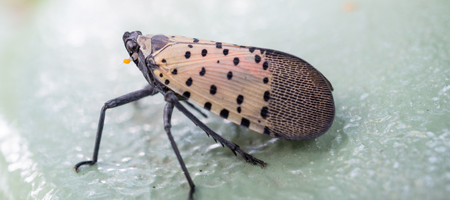Spotted Lanternflies: Pretty But BEWARE

The Spotted Lanternfly is a relatively new invasive species to the United States. Native to Asia, namely China, India and Vietnam, the spotted lanternfly was first documented in the U.S. in 2014, in Berks County, Pennsylvania. Spotted lanternflies are planthoppers like aphids, cicadas, or leafhoppers and are now considered an invasive species throughout southeastern Pennsylvania, southwestern New Jersey, northern Delaware, and northern Virginia. They are a huge threat to agriculture throughout the areas they invade.
Tale of the Tape
- Color: Red, black, and light brown with white and black spots
- Legs: 6
- Shape: Circular or oval-shaped at rest; have two pairs of wings creating butterfly-like appearance when spread
- Size: Adults are approximately 1” long, ½” wide at rest
- Antennae: No
Spotted lanternflies get their name from the distinguishable black spots on their front wings as adults. Adults have spotted forewings that cover brightly colored hind wings. Spotted lanternfly juveniles (known as nymphs) are usually 1/8 to 1/2 inch in size with white-spotted, black bodies changing to bright red coloration as they mature. Adults are larger than nymphs, around 1 inch in length and an inch and a half wide when wings are spread. Adults are typically easier to find because of their size, coloration, and increased mobility.
Habits
Spotted lanternflies hatch in the spring as wingless nymphs. The nymphs hop around and feed, molting several times before their final molt into adults that can fly. In the first three stages, nymphs are black with white spots and are easy to overlook. In their later stages, the nymphs are more conspicuous as they are larger and red in coloration. Adults begin to show up in late July and continue throughout October. They begin mating in September and the eggs are laid in masses while contained in a plaster-like covering.
While adults will continue to lay eggs until the frost kills them, the egg masses overwinter and hatch in spring. Each egg mass usually contains 30-50 eggs, and it is thought that a female can lay 2-3 egg masses before they die.
Do Lanternflies Bite?
Many have asked if they bite. They do not! However, their legs can cause a pinch if hanging on to your skin.
Can Lanternflies Damage My House?
No, not directly in the manner that termites or carpenter ants can affect structural damage. There can be secondary damage in the form of sooty mold or a deposit of an egg-like residue.
What Do Spotted Lanternflies Eat?
Spotted lanternflies eat sap from plants. They prefer Ailanthus trees, walnuts and grape vines as a first choice, most any other hardwood tree as a second choice and with much less frequency, pine trees. They have a very wide range of host plants.
Why are Lanternflies on My House?
Spotted lanternflies take advantage of any structure to rest or climb on. They have no interest in your house, other than its an obstacle. They also like to gather on warm house surfaces when the weather is cool.
Can Lanternflies Fly?
Indeed, spotted lanternflies can fly very well. They are not agile like a dragonfly or housefly, but more like a moth. While they are powerful hoppers, they can fly relatively high and far, but not with any great level of agility. They also tend to crash land. On a hot, breezy day they can be seen crashing into houses, cars, trees, or anything else in their way.
Why is My Tree “Raining”?
Spotted lanternflies suck sap and digest it, concentrating the sap into a sugar rich excretion (urine) that is commonly termed “honeydew”. The “rain” you are seeing is a high volume of spotted lanternfly honeydew falling from the branches above.

Why is My Tree, Porch or Deck Turning Black?
When you see a black coating beneath a tree infested with spotted lanternflies, you are looking at a fungus called “sooty mold” that is growing on the sugar rich honeydew dripping from the spotted lanternflies in the tree above. Sooty mold is mainly a nuisance but can damage low-lying plants beneath trees. It is unpleasant and requires lots of elbow grease to remove from patios, decks, and lawn furniture.

Should I Try to Kill Lanternflies
Homeowners are encouraged to help stop the spread of spotted lanternflies by checking cars and any outdoor equipment, like grills, firewood, and lawnmowers, when traveling in and out of the quarantined zones. If you find an infestation on your property, there are several spotted lanternfly control methods to manage the invasion, including:
- Scraping any visible egg masses off trees and properly destroying them.
- Removing the ‘tree-of-heaven’ if there are any growing on your property.
- Banding trees (adhesive tape that prevents lantern flies (and other insects) from migrating to the top of the tree) where spotted lanternflies are detected.
- When there are only a few insects, you can kill spotted lanternflies by swatting or crushing them. A simple solution of 1/4 cup of liquid dish detergent and one gallon of water sprayed on heavy enough to coat them is very effective at killing the lanternflies that you can safely reach.
If you are going to use an insecticide, it is best to contact an arborist for advice and or treatment as they are not a structural pest and an arborist is licensed to treat this issue on the property.
